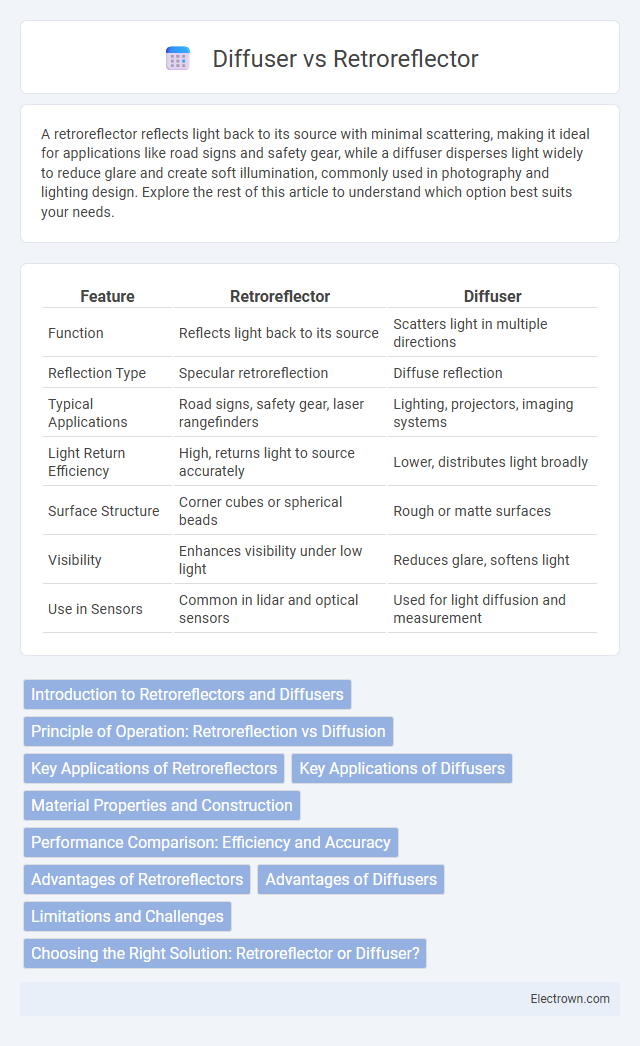A retroreflector reflects light back to its source with minimal scattering, making it ideal for applications like road signs and safety gear, while a diffuser disperses light widely to reduce glare and create soft illumination, commonly used in photography and lighting design. Explore the rest of this article to understand which option best suits your needs.
Table of Comparison
| Feature | Retroreflector | Diffuser |
|---|---|---|
| Function | Reflects light back to its source | Scatters light in multiple directions |
| Reflection Type | Specular retroreflection | Diffuse reflection |
| Typical Applications | Road signs, safety gear, laser rangefinders | Lighting, projectors, imaging systems |
| Light Return Efficiency | High, returns light to source accurately | Lower, distributes light broadly |
| Surface Structure | Corner cubes or spherical beads | Rough or matte surfaces |
| Visibility | Enhances visibility under low light | Reduces glare, softens light |
| Use in Sensors | Common in lidar and optical sensors | Used for light diffusion and measurement |
Introduction to Retroreflectors and Diffusers
Retroreflectors are optical devices designed to reflect light back to its source with minimal scattering, enhancing visibility and signal reliability in various applications such as traffic signs and laser communication. Diffusers scatter light in multiple directions to create a uniform illumination, widely used in displays, lighting fixtures, and imaging systems to reduce glare and shadows. Understanding the distinct functions of retroreflectors and diffusers helps optimize your lighting and optical system's performance based on precise reflection versus even light distribution.
Principle of Operation: Retroreflection vs Diffusion
Retroreflectors operate by reflecting light back toward its source with minimal scattering, using corner-cube prisms or microprismatic surfaces to maintain the incident angle. Diffusers scatter light in multiple directions, dispersing energy over a broad area to reduce glare and soften shadows. Understanding this fundamental difference helps you choose the right component for applications requiring precise light return or broad light distribution.
Key Applications of Retroreflectors
Retroreflectors are essential in applications requiring precise light or signal return, such as road signs, vehicle license plates, and safety gear, enhancing visibility in low-light conditions. Their ability to reflect light directly back to its source improves night-time driving safety and traffic control efficiency. Your safety equipment and navigation systems benefit significantly from the unique properties of retroreflectors in maintaining accurate and reliable visibility.
Key Applications of Diffusers
Diffusers are widely used in lighting design to evenly distribute light, reduce glare, and soften shadows in architectural, automotive, and photography applications. In optical sensing and laser systems, diffusers enhance beam uniformity and improve measurement accuracy by scattering light uniformly. Their ability to control light diffusion makes them crucial in displays, projectors, and interior illumination environments where balanced light distribution is essential.
Material Properties and Construction
Retroreflectors use highly reflective materials like glass beads or corner-cube prisms to return light directly back to its source, ensuring minimal scattering and high directional precision. Diffusers are made from translucent materials such as frosted glass or polymer films that scatter incoming light uniformly in multiple directions, reducing glare and creating soft illumination. Your choice depends on whether precise light return or broad light diffusion suits your optical application better.
Performance Comparison: Efficiency and Accuracy
Retroreflectors provide superior efficiency by reflecting light back to its source with minimal scattering, enhancing accuracy in applications like surveying and LIDAR systems. Diffusers scatter light broadly, reducing efficiency but enabling more uniform illumination for imaging or sensing tasks requiring wide-area coverage. Your choice depends on whether precise, high-accuracy reflection or diffuse light distribution better suits your performance needs.
Advantages of Retroreflectors
Retroreflectors provide superior light return efficiency by reflecting light back to its source with minimal scattering, enhancing visibility in low-light conditions. Their design ensures consistent performance over long distances and varying angles of incidence, making them ideal for traffic signs, road markers, and safety equipment. Compared to diffusers, retroreflectors offer increased durability and precision in directing light, reducing energy waste and improving signal clarity.
Advantages of Diffusers
Diffusers scatter light uniformly in multiple directions, enhancing visibility and reducing glare in various lighting conditions. They enable softer illumination, which is beneficial for photography, displays, and architectural lighting by minimizing harsh shadows. Diffusers also improve safety by spreading light across wider areas, facilitating better visibility in environments requiring diffuse illumination.
Limitations and Challenges
Retroreflectors face limitations such as sensitivity to alignment and reduced effectiveness over long distances or in diffuse lighting conditions, impacting their reliability in dynamic environments. Diffusers present challenges including lower directional control and reduced intensity of reflected light, which can diminish signal clarity in optical communication systems. Both technologies struggle with environmental factors like dust, moisture, and temperature variations that degrade performance and maintenance requirements.
Choosing the Right Solution: Retroreflector or Diffuser?
Choosing the right optical solution depends on the specific application requirements for light reflection and diffusion. Retroreflectors provide precise light return along the incident path, ideal for sensors and distance measurement systems requiring high accuracy. Diffusers scatter light over a wider area, enhancing uniform illumination in display technologies and ambient lighting where broad light distribution is essential.
Retroreflector vs Diffuser Infographic

 electrown.com
electrown.com